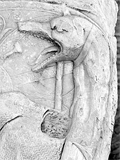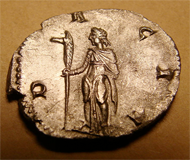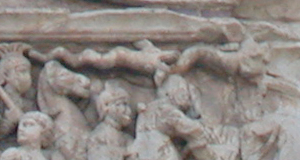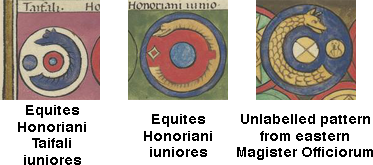
This page created 20 April 2014, and last modified: 8 December 2015 (references rearranged)

The Equites Honoriani Taifali iuniores is listed (102/5.18 in Ingo Maier's numbering scheme) as the sixth of the 32 vexillationes comitatenses in the Magister Equitum's cavalry roster; it is assigned (102/5.223) to his Gallic command as the Equites Honoriani iuniores. Its shield pattern (100#16) as shown in various manuscripts, under the plain label (100.q) Taifali, is as below:

Note that there is also a different unit listed (102/5.38) as the plain Honoriani iuniores in the Magister Equitum's cavalry roster, and under the Comes Africae we find such an Equites Honoriani iuniores (102/5.247). Because of the historical connections some historical Taifali are known to have had with Gaul but not with Africa (see below), it is more likely the Gallic Equites Honoriani iuniores refers to the Equites Honoriani Taifali iuniores than does the African Equites Honoriani iuniores.
However, be aware there is a possibility these two assignments are the wrong way aound. However, this possibility is probably slight, given the otherwise unknown Equites Taifali listed (102/5.256) under the Comes Britanniarum, which would appear to be one and the same as the Equites Honoriani Taifali iuniores, separated by both time and sapce. This unit may have bequeathed its name to a village in England called Tealby, formerly Teflesbi.
The shield shows a white ground with a purple (O, P) or white (M, W, B) boss encircled by red, along with two main charges, both in what appears to be purple (faded to pink in M, W): a disc at the 9 o'clock position (3 o'clock in B, which, being printed, revrses all the shield facings) and what appears to be a draco - a military standard that was introduced to the Roman forces during the 2nd century AD as a result of the Dacian wars, and which became more popular with time, to judge from e.g. Vegetius, in which a cohort is given its own standard, kept by a draconarius. Despite the name "draco" (serpent, dragon), illustrations of dracones often seem to feature a head that looks more wolf-like than serpent-like.

|

|

|
|
|
|
|
|
|
|
|
It is possible that the red band encircling the boss may originally have depicted a wreath, as can be seen in the much larger-scale picture of the Felices Arcadiani seniores (15.13) under the Magister Militum per Orientem.
Similarly, although the disc appears plain in the small Notitia picture 100#16, it might well have been an imperial imago (portrait) in real life. The disc in the much larger-scale shield pattern of the Domestici equites (30.2) under the eastern Comes Domesticorum is clearly such an imago. Further, such portraits had long been used as the components of Roman standards, so associating one form of standard - a draco - with another - an imago - might be particularly appropriate (note that vexillationes comitatenses, the unit category that the Equites Honoriani Taifali iuniores belongs to, refers to yet another type of Roman standard; a vexillum being a small flag hung from a cross-bar).
However, this unit's combination of draco and disc shield pattern has also been interpreted as early evidence for the "dragon and pearl" motif in western art that is usually associated with China. Although this east-west connection looks initially plausible given the appearance of apparent (but misleading) "yin-yang" symbolism in the Notitia, e.g. with the pattern of the Mauri Osismiaci (98/9.142), it loses force when one considers the pattern of similarly-named (Equites) Honoriani iuniores (102/5.38) and an unidentified pattern (106#5) associated with the western Magister Officiorum. These shields are shown below, using the patterns taken from the Paris manuscript:

The name Taifali comes from a tribal name first recorded in the mid-3rd century AD, although whether the Taifali were of mainly Germanic or Sarmatian ethnicity is debated. They fought in many conflicts during the 4th century both for and against Rome; in addition to various units incorporating the name Taifali listed in the Notitia, there is also a praefectus Sarmatarum et Taifalorum gentilium Pictavis in Galia (156/8.82) - i.e. a "prefect in charge of the Sarmatian and Taifali settlers at Poiteirs in Gaul". Their name lives on in the commune of Tiffauges, in the Pays de la Loire region of France.
Honoriani of course commemorates Flavius Honorius Augustus, who became the sole western Roman emperor at the age of 10, in 395 AD (he had been co-emperor for two years before this), and who died in 423 AD, thus reigning for essentially the entire span during which the western portion of the Notitia was being revised. As a consequence, a great many western units bear his name.
1. Ingo Maier; "Appendix 4: Numeration of the new edition of the compilation 'notitia dignitatum' (Cnd)"; last accessed 26 October 2015. See also for here for numbering examples. Return
2. Georgius Florentius Gregorius ("Gregory of Tours"); "Decem Libri Historiarum" (Historia Francorum); 4.13; available here in Latin (last accessed 3 December 2015). Return
3. Thomas Green; "Tealby, the Taifali, and the end of Roman Lincolnshire"; Lincolnshire History and Archaeology, Vol. 46 (2011), pp 5-10; available here (last accessed 8 December 2015). Return
4. Publius Flavius Renatus Vegetius ("Vegetius"); "Epitoma rei militaris", 2.13; available here in Latin and here in English (last accessed 3 December 2015). Return
5. Helmut Nickel; "The Dragon and the Pearl"; Metropolitan Museum Journal, Vol. 26, (1991), pp. 139-146; available here (last accessed 3 December 2015). Return

Return to the Notitia alphabetical unit list page.
Return to my Notitia index page.